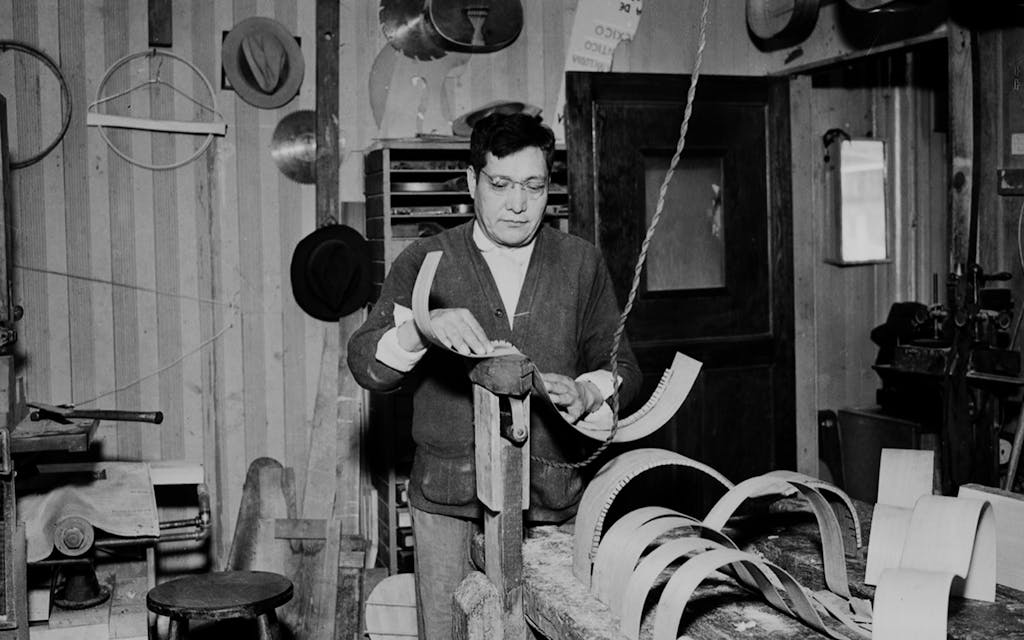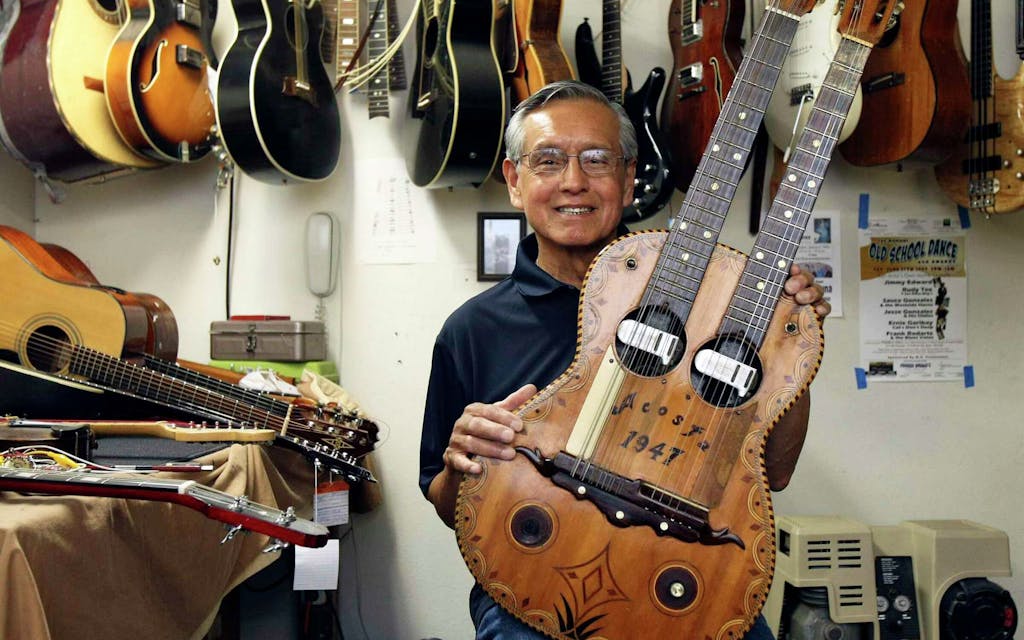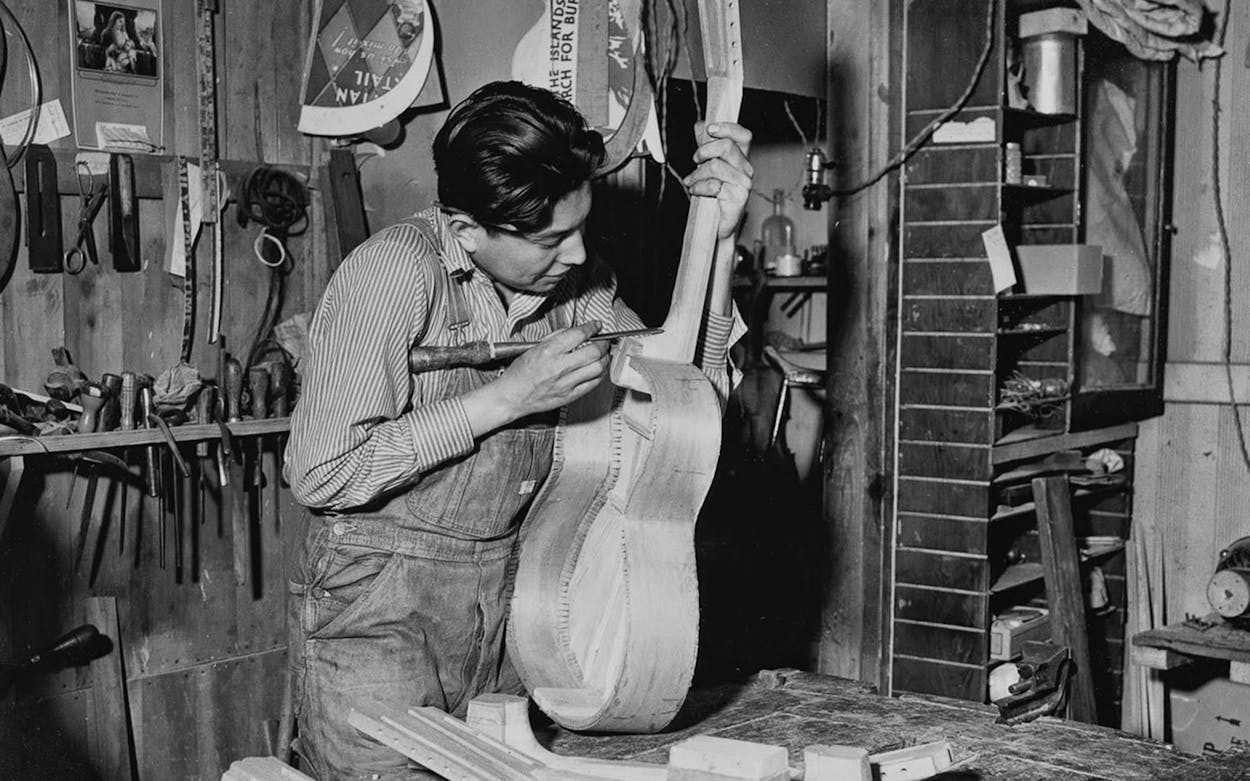Like rent and wisdom, appreciation often increases with the passing of time. Many families have a few heirlooms with sentimental value—a beloved china doll or a lunch pail from days of yore—but rarely do they cause a stranger to beg for details. This was one of those rare cases. On the first weekend of December, Sylvia Acosta Ramirez and her niece, Lisa Acosta Parker, stood on her family’s old back porch, chitchatting about the family’s handmade rarities with a nonchalance that would have caused some craftsmen and collectors to lose their damn minds. Among the dozen Acosta-made instruments behind the two women: a 1940s striped guitar fashioned from 4,100 wood pieces; a 1940s checkered guitar assembled from as many pieces or more; a 1970s guitar with a fish-shaped body; a 1950s eighteen-string bandurria shaped like an overweight arrow; and a 1947 double-neck acoustic guitar and bajo sexto—a creation that predated Gibson’s electric double-neck guitar by eleven years.
“We just took it for granted that there would be guitars,” said Parker. “We were always in Grandpa’s workshop in the back.”
“We never put dates or nothing,” Ramirez said.
“Yeah, it’s just a guitar,” Parker said.
“Nobody made a big deal,” Ramirez said.
In a West Side San Antonio backyard, under the papel picado, Acosta relatives celebrated the assortment of wildly creative instruments, fanned out like a museum display, on the family’s old wood-plank porch. “These are hard to find,” said John Ramirez, a repairman who’d been mentored by the Acosta family. He nodded at the collection. “I buy every stringed instrument that I came across most of my life—my wife went nuts because I kept buying them up—but I’ve never been able to find one of those.”

The clan’s San Antonio legacy started with Sylvia’s grandfather, the women explained: Guadalupe Acosta. Originally from Lagos de Moreno, Jalisco, the luthier-trained pioneer ventured north to evade the Mexican Revolution’s violence, eventually settling in San Antonio, where he opened the Acosta Music Company in 1920. Two of his seven children, Luis and Miguel, became the primary workers under him, and together the trio became the first San Antonio institution to handcraft instruments like the guitarras dobles, guitarras séptimas, and bandolónes.
Musicians noticed the luthiers’ craftsmanship. As anyone at the multigenerational gathering could have recited: blues player Lonnie Johnson bought a 1927 Acosta twelve-string; Lydia Mendoza purchased two 1930s Acosta-customized bajo sextos and an Acosta-customized twelve-string guitar. If you look at any photo of a San Antonio conjunto player from the 1920s, 1930s, or 1940s, there’s a good chance the guitar is an Acosta. (Q: Wasn’t Martin Macias the prime San Antonio bajo sexto maker? A: Yes, and he worked for the Acostas before he opened his own shop in the late twenties.) These aren’t just guitars.
Then Guadalupe closed the store in 1971. Luis died in 1975. Guadalupe died in 1979. Miguel’s son Mickey opened a new iteration of the store in 1974, working as a guitar technician and customizer, and when he retired in 2014, the shop closed. (Miguel died in 1998, and Mickey passed away in 2021, from COVID.)
With no more Acostas in practice, it seemed the family chapter in the history of guitar lore had ended quietly. Some of the guitars ended up in the trash can of an old family workshop that hadn’t been used since the nineties, said Mickey’s son Michael Acosta. “We were cleaning everything out, and a lot of these got flushed out of the closet,” he said.

He’s grateful now that no one ever took out the workshop trash. For years. In between greeting relatives at the back gate, Michael explained that in 2017, Wisconsin luthier Todd Cambio, of Fraulini Guitar Company, was recreating a version of Lydia Mendoza’s Acosta-customized twelve-string and grew curious about the company. He called Mickey Acosta, a conversation led to a visit, and Cambio eventually pulled the guitars out of the garbage, repairing the checkered and striped instruments.
“A lot of these, it’s just very meticulous, hard work,” Cambio said, surveying the instruments. I asked which one displayed the most confounding mastery. “The Acosta 1947,” he said, and he pointed to the double-neck acoustic. A cursive “Acosta 1947” was inlaid between the bridge and the sound hole. The perimeter of the body was outlined with blocks of alternating dark and light wood, and accentuated with an intricate, lace-like carved pattern. The overall effect was more like leatherwork. “That takes an incredibly sharp knife and chisel. And the little loops that go around it?” he shook his head in disbelief, eyebrows high. “Yeah.”
Most of the instruments that the company sold to the public were not as elaborate as those displayed on the porch, though they were recognized at the reunion as much as any uncle or aunt. These were personal instruments the family would use, often when performing as the trio Mike Acosta and His Troubadours. The instruments added flair to the boleros and rancheras they’d perform at shows such as the premiere of The Treasure of Pancho Villa at the Majestic Theatre or a convention of Russian diplomats at La Villita.
Sylvia Acosta Ramirez knew more about those shows than most of her siblings did. Though she is now 85, she maintains the posture, poise, and engaging smile from her days fronting the group in the fifties. One of the group’s best songs, she said, was “El Cumbachero,” a number that required little prompting for her to sing: “Cumba-cumba-cumba-cumbachero.” Around age 18, she went on, she fronted local big bands. She launched into a soft solo, with full vibrato: “Embrace meeee, my sweet embraceable youuuu . . . ” Then her voice started to catch. “Ugh! I’m too old!”
Flipping through black-and-white photos of the Acostas in the family shop, Michael Acosta said he’d love to hear from others who had Acostas in their possession so he could create a kind of catalog. (If you have a guitar with an Acosta label inside, please contact Michael at his dad’s old email, acostamusiccompany@yahoo.com.) “But I think the biggest concern is what to do with them after we’re all gone,” he said. “It’s easier to take them home and stick them in a closet.”
Already, he had heard from a guy in Seattle who’d found a discarded Acosta harp as he was walking down the sidewalk. Not the type to just leave others’ garbage well enough alone, the man asked the scrapped instrument’s nearest neighbor some version of, “What’s up with the harp?” “Apparently, the owner’s wife played it for years and then she died, so it went to the dumpster,” Michael said. “The guy who’d found it in the trash took it out and he doesn’t want to give it back yet. But it’s the first time that we know of a harp for which we’ve been able to locate a picture of the logo and everything.”
After mingling for awhile, Sylvia realized that one of the family guitars was missing from the collection. She sent one of her grandsons to the small house next door, where she stayed when visiting, to retrieve her own Acosta guitar to show the group. She explained that her dad made her the guitar when she was fourteen. “He said it was a feminine guitar, because it has a thin neck. See?” she said, and passed it to her grandson so he could wrap his hand around it. Despite her arthritis, she said, she wanted to play it more, but she needed it restrung. She’d taken it to a guitar center in Spring, where she spends much of her time now, and was disappointed to hear the repairman say he was afraid he’d break it if he touched it. “He said it was too old!” she said, offended. Several repairmen at the reunion, all of them mentored by the Acostas, immediately offered to do it, saying they had no such fear. She winked. “My daddy made them good,” she said.
- More About:
- Music
- San Antonio








